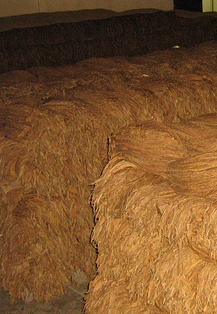Stogie Commentary: Making Sense of the Hype
24 Mar 2008
If you’re on any cigar mailing lists, or receive any catalogs, you’ve no doubt heard the story: A master tobacco blender discovers a cache of leaves hidden in a dusty corner of his factory. Curious about this long-lost supply, he rolls some of it up and – surprise, surprise – decides that it’s basically the greatest thing he’s ever tasted.
 Of all the silly narratives trotted out to hawk new cigar lines, this one seems to be popping up most frequently. If we are to believe it, then given the sheer number of “discoveries†made each month, cigar factories must be pretty shoddy operations – full of missing tobacco, abandoned buildings, and mismanaged supply chains.
Of all the silly narratives trotted out to hawk new cigar lines, this one seems to be popping up most frequently. If we are to believe it, then given the sheer number of “discoveries†made each month, cigar factories must be pretty shoddy operations – full of missing tobacco, abandoned buildings, and mismanaged supply chains.
It’s time to call BS on this myth. First of all, conditions in most cigar factories are heavily micromanaged. The idea that any supply of expensive, premium leaf – let alone enough to make 100,000 or more cigars – would go missing for a significant period of time is ludicrous. Second, methods for aging cigars are tightly monitored and rigorously controlled. If untouched, unsorted leaf in derelict shacks really matured better than tobacco under the normal aging process, what would be the point of that process? You get the idea. Placing this urban legend under even the slightest bit of scrutiny reveals its glaring implausibility.
What lesson can we learn from decoding the “treasure trove†myth and others like it? Quite simply, we realize that hype should not dictate our cigar purchases. Hype makes for some great reading material, but it should never inform significant investments in an already pricey hobby. Instead, we should buy cigars because we’ve done our homework. We’ve read reviews, scoured the message boards, boned up on the blogs, and solicited opinions from fellow enthusiasts.
Colorful ads are a sexy and enduring legacy of cigar culture. They will always be around, and we can always get a kick out of them. But we would do well to keep them in perspective – and so would our wallets. Until the day we happen upon a missing pile of perfectly aged, hand-rolled greenbacks in our basements, that is.
photo credit: Flickr

 Patrick Ashby
Co-Founder & Editor in Chief
Patrick Ashby
Co-Founder & Editor in Chief Patrick Semmens
Co-Founder & Publisher
Patrick Semmens
Co-Founder & Publisher George Edmonson
Tampa Bureau Chief
George Edmonson
Tampa Bureau Chief
Well said Jon. I can't say that I ever paid much attention to the stories like I did the cigar itself. Do they really think we are just a big bunch of stogie smokin suckers? Oh well… still makes for a good fairy tale!
I'm a noob, Jon, so I haven't heard/read any of these fables yet. Can you give us a few examples?
The most common of these fairly tales would be the magical location of a stash of pre-embargo Cuban tobacco in some old forgotten warehouse in Ohio. As the tobacco somehow escaped the ravages of time and humidity in an unaltered and pristine state, we are now able to offer to you, lucky smoker, a sample 5-pack of robustos for ONLY $59.99!!! Can you believe this deal???
Rocky V: As Furious so humorously (but, sadly, accurately) points out, the treasure trove myth usually involves "pre-embargo Cuban tobacco" that has somehow survived since pre-1962 in abandoned warehouses and has recently been rediscovered. The pre-embargo myth is sketchy at best, given that tobacco, like any plant-based organic material, decays under everyday conditions (such as those in an abandoned warehouse). Unless kept in a tightly controlled environment, tobacco and tobacco products will deteriorate rather rapidly. There is basically no way that unaccounted-for, untouched, un-cared-for leaf from 1962 or earlier would be suitable for use in a cigar today. And yet, somehow, boutique manufacturers seem to stumble across pre-embargo tobacco on a monthly basis.
But the myth isn't limited to magical Cuban leaf. Often it involves "lost" supplies of tobacco at Nicaraguan or Dominican factories that, when rediscovered, always turn out to be far superior to their accounted-for counterparts.
If we really wanted to be mean, we could call out specific producers for their overuse of the treasure trove story. But I'm not that mean. 🙂 Perhaps someone else is?
B Casanova: You raise an interesting question, actually. Do they think we're a bunch of suckers?
I don't think so, per se. I think what's going on is that most catalogs — and the ads they contain — are aimed at newbies: people who've made one or two purchases online, but who aren't yet hooked on cigars as a hobby or lifestyle. These are the kinds of people who won't know any better when they stumble across an appealing tall tale. They'll read about the magical pre-embargo leaf, and they'll think, "Wow. I bet this is going to be crazy!" And it IS crazy — just not in the way they're probably anticipating.
Now, I get a few catalogs here and there. And I'm on a few e-mailing lists. But I mostly just look at the pretty pictures and avoid the copy. I'm like the one honest Playboy reader out there: I'm NOT reading it "for the articles."
I mean, sure, I'll read the ads and the stories and all that. But always as entertainment, and seldom as truth.